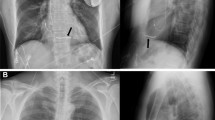Opinion statement
The role of leadless devices to treat cardiac rhythm disorders and heart failure is emerging. Subcutaneous defibrillator (S-ICD) and leadless pacemakers were developed to ameliorate the risks associated with chronic transvenous leads. Potential benefits of leadless pacemakers and S-ICD include more favorable infection profile, less risk of venous stenosis or occlusion, and less risk of tricuspid valve insufficiency. Novel implantable leadless monitors for heart failure represent a novel diagnostic tool that can guide therapy for CHF.



Similar content being viewed by others
References and Recommended Reading
Papers of particular interest, published recently, have been highlighted as: • Of importance •• Of major importance
Kleemann T, Becker T, Doenges K, Vater M, Senges J, Schneider S, et al. Annual rate of transvenous defibrillation lead defects in implantable cardioverter-defibrillators over a period of >10 years. Circulation. 2007;115:2474–80.
Maron BJ, Spirito P, Shen W-K, Haas TS, Formisano F, Link MS, et al. Implantable cardioverter-defibrillators and prevention of sudden cardiac death in hypertrophic cardiomyopathy. JAMA. 2007;298:405–12.
Hreybe H, Razak E, Saba S. Effect of end-stage renal failure and hemodialysis on mortality rates in implantable cardioverter-defibrillator recipients. PACE - Pacing Clin Electrophysiol. 2007;30:1091–5.
Luedemann M, Hund K, Stertmann W, Michel-Behnke I, Gonzales M, Akintuerk H, et al. Implantable cardioverter defibrillator in a child using a single subcutaneous array lead and an abdominal active can. PACE - Pacing Clin Electrophysiol. 2004;27:117–9.
Cannizzaro LA, Piccini JP, Patel UD, Hernandez AF. Device therapy in heart failure patients with chronic kidney disease. J Am Coll Cardiol. 2011;58:889–96.
Baquero GA, Luck J, Naccarelli GV, Gonzalez MD, Banchs JE. Tricuspid valve incompetence following implantation of ventricular leads. Curr Heart Fail Rep. 2015;12:150–7.
Supple GE, Ren J-F, Zado ES, Marchlinski FE. Mobile thrombus on device leads in patients undergoing ablation: identification, incidence, location, and association with increased pulmonary artery systolic pressure. Circulation. 2011;124:772–8.
Wazni O, Epstein LM, Carrillo RG, Love C, Adler SW, Riggio DW, et al. Lead extraction in the contemporary setting: the LExICon Study. An observational retrospective study of consecutive laser lead extractions. J Am Coll Cardiol. 2010;55:579–86.
Knops RE, Olde Nordkamp LR, De Groot JR, Wilde AA. Two-incision technique for implantation of the subcutaneous implantable cardioverter-defibrillator. Hear Rhythm. 2013;10:1240–3.
Bardy GH, Smith WM, Hood MA, Crozier IG, Melton IC, Jordaens L, et al. An entirely subcutaneous implantable cardioverter-defibrillator. N Engl J Med. 2010;363:36–44. Novel.
Weiss R, Knight BP, Gold MR, Leon AR, Herre JM, Hood M, et al. Safety and efficacy of a totally subcutaneous implantable-cardioverter defibrillator. Circulation. 2013;128:944–53.
Olde Nordkamp LR, Dabiri Abkenari L, Boersma LV, Maass AH, De Groot JR, Van Oostrom AJHHM, et al. The entirely subcutaneous implantable cardioverter-defibrillator: initial clinical experience in a large Dutch cohort. J Am Coll Cardiol. 2012;60:1933–9.
Jarman JWE, Todd DM. United Kingdom national experience of entirely subcutaneous implantable cardioverter-defibrillator technology: important lessons to learn. Europace. 2013;15:1158–65.
Jarman JWE, Lascelles K, Wong T, Markides V, Clague JR, Till J. Clinical experience of entirely subcutaneous implantable cardioverterdefibrillators in children and adults: cause for caution. Eur Heart J. 2012;33:1351–9.
Olde Nordkamp LRA, Warnaars JLF, Kooiman KM, de Groot JR, Rosenmöller BRAM, Wilde AAM, et al. Which patients are not suitable for a subcutaneous ICD: incidence and predictors of failed QRS-T-wave morphology screening. J Cardiovasc Electrophysiol. 2014;25:494–9.
Kooiman KM, Knops RE, Olde Nordkamp L, Wilde AA M, De Groot JR. Inappropriate subcutaneous implantable cardioverter-defibrillator shocks due to T-wave oversensing can be prevented: implications for management. Hear Rhythm. 2014;11:426–34. Method to improve sensing using the S-ICD.
Lambiase PD, Barr C, Theuns DAMJ, Knops R, Neuzil P, Johansen JB, et al. Worldwide experience with a totally subcutaneous implantable defibrillator: early results from the EFFORTLESS S-ICD registry. Eur Heart J. 2014;35:1657–65.
Acha MR, Milan D. Timing is not right to replace the transvenous implantable cardioverter defibrillator. Circ Arrhythmia Electrophysiol. 2013;6:1246–51.
Spickler JW, Rasor NS, Kezdi P, Misra SN, Robins KE, LeBoeuf C. Totally self-contained intracardiac pacemaker. J Electrocardiol. 1970;3:325–31.
Reddy VY, Knops RE, Sperzel J, Miller MA, Petru J, Simon J, et al. Permanent leadless cardiac pacing: results of the LEADLESS trial. Circulation. 2014;129:1466–71. Novel description of a leadless pacemaker in man.
Ritter P, Duray GZ, Steinwender C, Soejima K, Omar R, Mont L, et al, Micra Transcatheter Pacing Study Group. Early performance of a miniaturized leadless cardiac pacemaker: the Micra Transcatheter Pacing Study. Eur Heart J. 2015. First experience with the Medtronic Micra leadless pacemaker.
Adamson PB, Magalski A, Braunschweig F, Böhm M, Reynolds D, Steinhaus D, et al. Ongoing right ventricular hemodynamics in heart failure: clinical value of measurements derived from an implantable monitoring system. J Am Coll Cardiol. 2003;41:565–71.
Abraham WT, Adamson PB, Bourge RC, Aaron MF, Costanzo MR, Stevenson LW, et al. Wireless pulmonary artery haemodynamic monitoring in chronic heart failure: a randomised controlled trial. Lancet. 2011;377:658–66. First trial showing benefit for leadless pulmonary artery pressure monitor.
Author information
Authors and Affiliations
Corresponding author
Ethics declarations
Conflict of Interest
The authors declare that they have no competing interests.
Human and Animal Rights and Informed Consent
This article does not contain any studies with human or animal subjects performed by any of the authors.
Additional information
This article is part of the Topical Collection on Arrhythmia
Rights and permissions
About this article
Cite this article
Arkles, J., Cooper, J. The Emerging Roles of Leadless Devices. Curr Treat Options Cardio Med 18, 14 (2016). https://doi.org/10.1007/s11936-015-0424-8
Published:
DOI: https://doi.org/10.1007/s11936-015-0424-8




